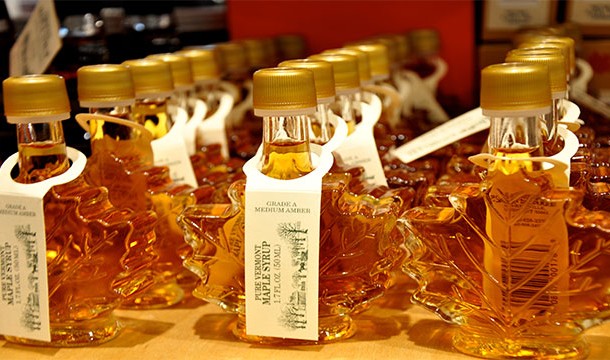As New England prepares for the maple sugar season, sugar houses around the region make sure everything is clean, wood stacked, lines ready to go.
The origins of maple sugaring (the practice of making maple syrup from sap) are steeped in legend. Native Americans began the practice long before Europeans arrived in North America. However, no one knows what tribe first discovered it. There are multiple legends regarding its discovery.
One story states that Prince Glooskap found his people lazily drinking maple syrup right from the trees instead of working. As punishment, he added water to the syrup and made the sap only available in spring. Now, the people would have to boil down the sap instead of being lazy. Similarly, another story puts Kokomis, the son of the Earth Mother, in the role of Prince Glooskap. A third story, from the Chippewa and Ottawa tribes of Michigan states that the god NenawBozhoo cast the spell. [1]

A different legend, retold in The Atlantic Monthly’s April of 1896 issue, tells of a woman named Moqua. It states that she was cooking moose for her husband Woksis. When her boiling pot ran out of water, she refilled it with maple sap. The boiled down sap formed syrup in the pot. [1]
There is one other legend that tells of a chief who threw his tomahawk into a tree. The tree began to drip with sap. This sparked the idea for his wife to cook meat in the sap. The final result was a delicious syrupy meal. It is said that this chief was the first to use the word Sinzibuckwud which means “drawn from trees”. Native Americans often used this word to refer to maple syrup. [1]
Early Native American methods of sap collection involved cutting a V shape into the bark of the maple tree and placing a wedge at the bottom of the cut. Sap would flow out of the wedge and into baskets that were placed at the base of the tree. Sometimes, Native Americans made these baskets of wood hollowed out with a hatchet. They used these year after year. Others were made of bark and were only used for one season. The sap was collected and slowly boiled until it became syrup. At this point, they would allow it to cool and it would be kept in baskets. Generally, the gathering and boiling of sap was done by women in the tribe. [2]
 The 1800s saw many innovations in sap boiling. Around the year 1850, large flat metal pans became available. The increased surface area proved to be much more efficient than the previously used iron kettles. In the late 1800s a two pan evaporator became available which cut even more time from the process. Then, around 1900, the tin in the bottom of the pan was made to form flues which increased surface area even more. [3]
The 1800s saw many innovations in sap boiling. Around the year 1850, large flat metal pans became available. The increased surface area proved to be much more efficient than the previously used iron kettles. In the late 1800s a two pan evaporator became available which cut even more time from the process. Then, around 1900, the tin in the bottom of the pan was made to form flues which increased surface area even more. [3]The 1800s saw many innovations in sap boiling. Around the year 1850, large flat metal pans became available. The increased surface area proved to be much more efficient than the previously used iron kettles. In the late 1800s a two pan evaporator became available which cut even more time from the process. Then, around 1900, the tin in the bottom of the pan was made to form flues which increased surface area even more. [3]
Because of the increased availability of cane sugar during the 1800s, producers switched their focus from maple sugar to maple syrup. Further technological innovations made it easier for them to produce larger quantities of this syrup. Soon, plastic bags replaced the buckets that were hung from taps. Also, tractors began to replace the draft animals used to haul large quantities of sap from trees to the sugar shack. In addition, producers sometimes used motor-powered tappers and metal tubing systems to simplify the transfer of sap from trees to evaporator. There were also more fuel options available for heating; in addition to wood, oil, natural gas, propane, and steam were also available. Finally, filtration was also improved for a purer final product. [3]
“Gathering and processing maple syrup, ca. 1900”; 1900; courtesy of Library of Congress
Do you know a great sugar house? Have some great photos you would like to share with our audience? Let us know about it.
References
- “History” Michigan Maple Syrup Association. Retrieved 5 December 2017. https://web.archive.org/web/20110525093903/http://www.mi-maplesyrup.com/about/history.htm
- 2. Zeisberger, David, 1721-1808; Hulbert, Archer Butler, 1873-1933; Schwarze, William Nathaniel, 1875-1948; David Zeisberger’s History of the Northern American Indians. Columbus, O., Press of F.J. Heer. pp. 48-51. https://archive.org/details/zeisbergerhistnaind00zeisrich
- 3 Melvin R Koelling; Randal Bruce Heiligmann; Timothy D Perkins; Ohio State University Extension; North American Maple Syrup Council; North American Maple Syrup Producers Manual. [Columbus] : Ohio State University Extension, ©2006. http://estore.osu-extension.org/North-American-Maple-Syrup-Producers-Manual-PDF-Only-P320.aspx
Visited 1 times, 1 visit(s) today


